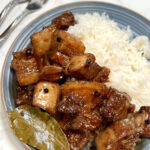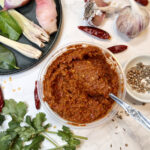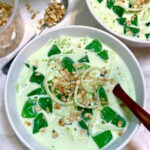This Japanese egg sandwich, also known as ‘tamago sando’, is a classic and popular sandwich found all over Japanese convenience stores. The filling is rich and creamy, all between two slices of fluffy milk bread!
What is tamago sando?
Tamago sando is one of those grab-and-go type foods that are cheap, comforting, and made to eat as a quick snack.

If you’ve ever had Western-style egg salad sandwiches, you’ll realize that these are very, very similar, if not identical (with just a couple ingredient substitutes). I do find the Japanese-style sandwiches to be slightly more rich and creamy, with a stronger, more pronounced egg flavor (since it doesn’t require much spices or vegetables compared to the Western version).
Regardless of your preference, Japanese egg sandwiches are definitely a must-try if you’re a fan of egg salads in general, or if you’re looking for a simple, yet tasty snack on-the-go.
It’s savory, umami, and bursting with egg-yolk flavor!
Want more quick and easy meal ideas? Here’s a couple recipes from our 20-minute meal series:
Ingredients for Japanese egg sandwich
Servings: 2 sandwiches
- 6 eggs (4 hard-boiled, 2 soft-boiled)
- 2-3 tbsp Kewpie mayonnaise, depending on how creamy you want the filling to be
- 2 tsp milk or cream
- 1/2 tsp sugar
- 1/4 tsp salt, to taste
- Unsalted butter, softened
- 4 slices of milk bread (shokupan)
- Dried parsley or chives, for topping
Kewpie mayonnaise
Kewpie mayonnaise is one of the staple condiments in my kitchen, and I always make sure to stock up on it whenever I’m running low. You can almost always find these in Asian groceries, but it’s becoming more commonly sold now in even standard supermarkets!
It’s essentially the Japanese version of the standard Western mayonnaise, but with slight variations.
For one, while Western mayo uses whole eggs, Kewpie mayo only uses egg yolks. The resulting texture is slightly more custardy, with its flavor profile being much more rich, savory, and fatty, thanks to the yolks.
The seasonings that go into the mayonnaise also differ slightly. Japanese mayonnaise uses a variety of vinegars such as rice vinegar or apple cider to give it its signature tang and a tiny bit of sweetness.
You can use Kewpie mayonnaise in almost everything! It can be used as a topping, a dip, or even as a spread. Popular Japanese recipes that use this include Okonomiyaki (Japanese savory pancake), but it’s recently been popularized all across Asia, going as far as Vietnam, for their famous Vietnamese Pizza (Banh Trang Nuong), or the Philippines, used in Tofu Stirfry (Tofu Sisig).
In a pinch, standard Western mayonnaise can also work! I’d highly urge you to compare the two mayonnaise and see which one you prefer the most.
Japanese milk bread (shokupan)
Shokupan, or Japanese milk bread, is the other key component for this recipe. It’s made up of yeast, white flour, butter, sugar, salt, and of course: milk!
It’s fluffy, soft, pillowy, and has a slight sweet-milky taste that compliments any spread or filling perfectly.
You can typically find these being sold fresh in most Asian groceries or bakeries, either with a flat top or a rounded top. Of course, feel free to use any homemade milk bread you happen to already have, this sandwich will be a wonderful way to reward yourself for all that effort!
If you don’t have any luck, one of the closest substitutes to shokupan in terms of texture is brioche. I find it does taste slightly sweeter and is more on the eggy side than regular milk bread, but it does the job fine.
Otherwise, feel free to use standard white bread as another substitute.
Instructions for Japanese egg sandwich
Bring a pot of water to a boil. Add in the eggs and set a timer for 11 minutes.
When there’s 3 minutes left on the timer, remove 2 eggs and immediately place them in an ice bath to cool (these will be our soft-boiled eggs; set them aside until we assemble the sandwich).
Continue boiling the remaining eggs until the timer goes off (for the for the full 11 minutes), then place them in an ice bath to stop the cooking process.


With the hard-boiled eggs, peel them, then separate the yolks from the whites.

Mash up the yolks and mix in the Kewpie mayonnaise, milk/cream, sugar, and salt until smooth.

Dice the egg whites and mix it in with the yolk mixture. This will be our sandwich filling.


To assemble: Spread softened butter on both pieces of milk bread. Cut the soft-boiled eggs in half and place the halves face-down onto the center of the bread. Spread half of the egg filling mixture to fill the sandwich, then top it off with the other slice of bread. Cut off the crusts for a more cleaner look, if desired.
Repeat for the other sandwich.


Top with parsley or chives. Serve immediately or refrigerate to be eaten the next day!

Final tips
- Having the soft-boiled eggs in the Japanese egg sandwich is completely optional. I like to keep them in there for some textural differences (the yolks lend a nice custardy mouthfeel!) and for a prettier cross-section, but feel free to keep all the eggs hard-boiled for the filling.
- You can prepare these sandwiches the night before, but I’d recommend consuming them the next morning for optimal taste and texture. Anything longer and the bread can get soggy from absorbing too much moisture.
- You can batch-make the egg filling and store them in an airtight container for up to three days in the refrigerator. When you’re going to eat, simply spread the egg filling onto your bread and enjoy!
Disclosure: Some links on this page are affiliate links, meaning that at no additional cost to you, we may receive compensation from purchases made through these links. As an Amazon Associate, I can earn from qualifying purchases.








Pingback: Beef Curry Stir-Fry (Chinese Takeout Style) | Iankewks
Pingback: Coconut Chicken Adobo | Iankewks
Pingback: Honey Walnut Shrimp | Iankewks
Pingback: Ramen Eggs (Ajitsuke Tamago) | Iankewks